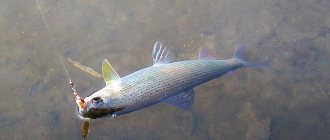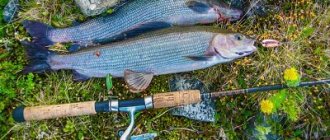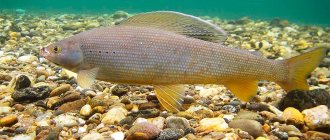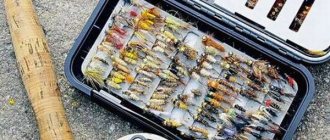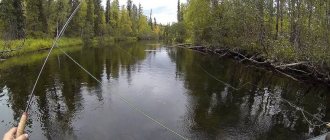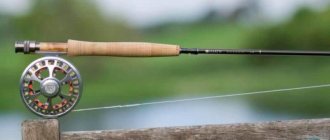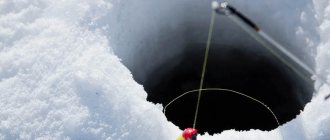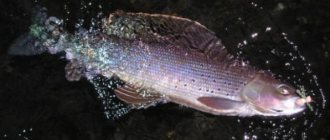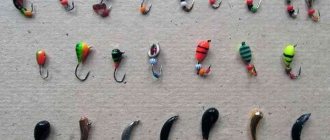Winter fishing for grayling is a fascinating and quite adventurous activity, because you can’t find this capricious fish everywhere. Graylings prefer to settle in cold rivers with fast currents and clean water. Therefore, it makes no sense to go fishing to reservoirs located close to major highways and big cities. Fishing in winter is also complicated by the fact that this is a rather cunning fish, and it is not always possible to lure it.
Despite certain difficulties, many winter fishing enthusiasts are ready to go on a long journey to catch grayling and enjoy its delicious meat. For fishing to be successful, you need to prepare your gear in advance, select bait and lures, and study the habits of this fish in the cold season.
Winter grayling fishing basics
Grayling is not only a tasty, but also a very beautiful fish that can decorate any catch. But to get such a trophy, you should go fishing to cold mountain and northern rivers, because in winter this aquatic inhabitant prefers to settle in just such an environment.
Note: Lake Baikal is considered the best place for fishing, but this aquatic inhabitant can also be found in other bodies of water. The main thing is to choose the right fishing area and prepare your gear in advance.
Figure 1. Winter fishing for grayling is a fascinating and challenging activity.
Winter fishing is complicated by the fact that with the advent of cold weather, all inhabitants of the reservoir decrease in activity, and they rarely move long distances.
Therefore, it is better to spend more time searching for a suitable place for fishing than to return from fishing empty-handed. Theoretical information about the habits of fish in winter will help you with this (Figure 1).
Tips for catching grayling
A few tips for catching winter grayling will not be superfluous even for experienced anglers:
- The bait must be constantly in motion so that its active play attracts the attention of the fish and provokes an attack.
- It is better to start fishing by drilling holes at the boundaries of holes and underwater hills, where grayling will first spin.
- The best fly for catching grayling in winter is a “nymph”, as it perfectly imitates a caddis fly larva.
- When choosing a jig for fishing for grayling, you must first of all pay attention to its shape - it should be flat in order to more persistently resist the flow of water in the current when retrieving and pulling.
- When fishing, it is better not to focus on the holes alone, but try to catch grayling at shallow depths and shallow waters. Especially on the first and last ice, because the fish swim closer to the shore in search of food.
- When fishing from ice, it is worth fishing all water horizons, since grayling can be at any depth.
Tackle for grayling in winter
If you plan to fish on a small river, then you can use almost any gear: in such reservoirs, grayling can be caught well with a jig, a donk, and a spoon. But to make it easier for you to decide on the choice of gear, we will present several of the most popular and effective options (Figure 3).
Before choosing the type of tackle, let’s focus on the appropriate equipment for a winter fishing rod:
- The size of the catch directly depends on the fishing line. It is clearly visible to fish in clean, clear water, so to increase your chances of catching fish, it is better to take fluorocarbonate fishing line with a diameter of 0.12 mm. With its help, you can easily fish a specimen out of the water, because the average weight of this fish rarely exceeds 1.5 kg.
- It is better to use a jig as bait, but hybrids of jigs with artificial flies are also suitable. It is advisable that the bait be copper, lead or golden in color, since these are the shades that attract fish best.
- To increase the effectiveness of the tackle, you can attach an additional leash 2-3 cm long with an artificial fly to the fishing line.
Figure 3. Gear required for winter fishing
If you are going to fish on stormy mountain rivers that are not covered with water, you can use regular summer gear.
Jigs
To catch grayling in winter, you can use regular bloodworm gear. In fact, this is a winter fishing rod with a nod that shows the bite (Figure 4).
To choose the right jig, follow these tips:
- It is better to take an attachment model with a medium-length forend.
- It is advisable to use lead or tin baits, as they play better in the water and attract fish.
- When choosing a jig, be sure to pay attention to its shape. Flat tackle with good water resistance is considered the best.
Figure 4. The most tricky types of jigs
In some cases, there is a need to use jigless gear with a sinker attached to the lower end of the fishing line and a hook suspended from the side leash. The main advantage of such winter gear is that it is clearly fixed to the bottom at one point and effectively resists the current, while the bait oscillates. This gives the fisherman some room to maneuver and play to attract prey. With a regular jig fishing rod, such manipulation will not be possible, since the nozzle will constantly be carried away by the current.
Spoon
From the previous section we can conclude that it is better to catch grayling in winter using a jig or a bottom fishing rod, and all these methods involve the use of bait that attracts the attention of fish (Figure 5).
Note: In the next section we will take a closer look at natural baits, the smell and appearance of which can attract the attention of fish. However, fishing with live bait is far from the only effective way. Fishing with lures can be no less effective.
Using a spoon for fishing can be really successful, because in natural conditions this fish feeds on invertebrates, and less often on fry. The spoon is especially good for catching medium and large sized specimens. It can be used for both bottom and vertical fishing, but in this case some kind of bait must be attached to the tackle. As a rule, baits are used for this purpose.
There is also a certain glittering technique:
- The bait is first supplied to the water level that is currently being fished.
- Then they make a sharp swing with the rod so that the bait rises in the water column by about 30 cm.
- After this, lower the rod again to its previous position and, after a short pause, repeat the swing.
Figure 5. Spoons for catching grayling
This kind of spinner play helps to attract the attention of the fish, since the grayling perceives the bait as an edible object.
It is worth noting that lure fishing is not common in all regions. Most often, this method is used on deep rivers of Siberia, such as the Lena and Yenisei.
Fishing for grayling in summer on small rivers
Fishing in summer begins from the very first days of June during this period, as mentioned earlier, the most active bite begins. With the approach of July, when small rivers enter their channel after a leash, the fish have already settled in the parking areas and have regained their strength after spawning.
Tips for fisherman: Grayling in the oven in foil recipes - All the nuances
In July, the bite worsens significantly due to the abundant food supply. A large number of different insects are starting to be fed into the rivers, so you will have to try to get the grayling to grab your bait.
But all the same, the fish continue to bite, so you shouldn’t neglect fishing in the middle of summer. By the end of August, the bite begins to intensify again and continues until mid-autumn as the fish begins to prepare for the winter.
Grayling is a small, beautiful fish that can still be found in many rivers and streams of the Leningrad region, sometimes without even traveling far from the city.
Morozov I. | November 12, 2000
If now someone asks me what kind of fish, after the traditional pike and perch and trout, can be caught with a spinning rod without going far from the city, I will answer without hesitation: grayling.
Grayling is a small, beautiful fish that can still be found in many rivers and streams of the Leningrad region, sometimes without even traveling far from the city.
However, “small” is not entirely true: for example, Ladoga graylings that come to spawn in the Nazia River (and other rivers flowing into Ladoga and Neva) can weigh more than a kilogram, and even at a decent distance from the city, for example in the southwest region, grayling can reach considerable weight. For the most part, settled river grayling weighs 100-150 grams. However, hunting for this fish, which is very easily identified by the “flag” on its back, can be a great pleasure for fans of light spinning rods.
Grayling has many similarities with brook trout. Very often these two fish not only live side by side in small rivers, but are also caught in the same places. There were cases when, from under the same snag, I pulled out first grayling and then trout, or vice versa. At the same time, I met grayling in large numbers not only on a calm current, but also on rocky rifts, where it stands behind large stones, thus hiding from the fast current, and on the echoes of streams.
For example, when I come fishing on the river. Sister, then first of all I start looking for him there. In addition, its mooring sites can be identified by small graylings, which in good weather like to play on the surface of the water. In winter, on the contrary, its capture is most likely in deeper places: with the onset of cold weather, grayling, like trout, falls into holes. I catch it exclusively on spinners, mainly with zero and penny.
Unlike trout, the deuce is too big for small graylings, but with a good bite, a three-hundred-gram grayling will take it without any problems. It is best to cast across the riffle in such a way that the current slowly carries the lure past its intended resting place. Retrieving, as when fishing for trout, should be slow, sometimes to the point of disrupting the action of the spinner blade. It is best to lead the spoon across or against the current. Driving the spoon downstream, in my opinion, is undesirable and pointless.
Grayling, unlike trout, is unlikely to covet a bait quickly rushing past it; most likely, it will not pay any attention to it or will simply be afraid to take it. Of the spinners with which I caught grayling, spinners from the Polish companies WIREK and DRAGON, mostly dark colors with different patterns on the petal, worked very well, and in muddy water, grayling responded well to silver BLUE FOX.
Probably for an hour I tried to find the key to the current situation: I changed the pace of the retrieve, placed spinners of different colors and with different petal shapes, but in the end I still capitulated: I placed a spinner, which, in the color and shape of its petal, almost copied the spinner identically. , which my friend fished with.
Tips for fisherman: Fishing for grayling on small rivers in winter - Tips for beginners
It was a Wirek turntable, model ROUND number one, with a black petal covered with green dots and a red cambric on the tee. Literally ten minutes after this forced “plagiarism” the long-awaited grayling was finally hooked. And it happens that everything turns out exactly the opposite.
For beginners or those simply wanting to try catching grayling with a spinning rod, I can advise the following: go out onto the pond with self-confidence. There is nothing complicated here, it’s just that in spinning, as in any other type of fishing in general, there are some nuances that you need to know and take into account. And knowledge, and most importantly, confidence comes with practice. The main formula for success is this: never give up and believe in luck.
So, let us immediately note that grayling is a very cautious fish. The slightest danger will force the fish to leave the most promising and richest place for food. Grayling has ideally developed vision and hearing; in addition, the fish has a sensitive lateral line. Grayling can be scared not only by an object falling into the water or a shadow from the fisherman himself, but also by the shadow that will be formed by the fishing rod.
Lure and bait for grayling in winter
Much greater results can be achieved by fishing not with bait, but with bait, natural or artificial. Each of these methods has certain features, so they should be considered in more detail to make it easier for you to choose the type of bait (Figure 6).
The most commonly used natural baits are:
- Bloodworm: the simplest and most affordable bait option, because bloodworm can be bought at any fishing store. In addition, this species very readily bites on bloodworms, and for fishing you can use both hook and jig tackle, setting two or three baits. In the dead of winter, fishing with just one bait can give a good result.
- Dung worms: you can prepare such bait yourself, but in large cities such worms are also sold in stores. This is a fairly noticeable bait with a pronounced smell, so grayling responds quite well to it, but the maximum catch will be observed during the period of the highest fish activity, and not in the dead of winter.
- Wood-boring beetle larvae: Bark beetle larvae can be harvested in the fall and stored in a cool shed in a box with sawdust. It is bark beetle larvae that are considered ideal bait, since fish swallow such bait very willingly.
Figure 6. The best natural baits
Practice shows that grayling is most readily caught using bark beetle larvae, although you can try to catch it using other types of natural bait, for example, maggots, jigs, or wormwood and burdock moth larvae.
In some cases, successful fishing is also possible when using artificial baits, which imitate an insect in appearance and movements in the water. According to experienced fishermen, this fish most readily bites on “nymphs”, which in appearance resemble arthropods. The fact is that terrestrial insects hibernate in winter, and underwater inhabitants remain active and become prey for grayling, so using artificial bait that imitates the movements of such insects really makes sense.
Experienced fishermen advise using artificial and natural baits at the same time, since in this case the likelihood of getting a rich catch increases significantly, especially in the dead of winter.
Tackle for fishing grayling from ice
Grayling is an omnivorous fish and can be caught with almost any tackle. Among the main fishing gear and methods it is worth noting.
Float fishing rod
Typically used in areas with rough currents and open water. They are caught in the wire, hooking bait of animal origin:
- mormysha,
- bloodworm,
- maggot,
- dung worm,
- insect larvae, etc.
It is better to attach the weight at a considerable distance from the hook so that it does not frighten cautious fish. Fishing line - from 0.14 mm in diameter. This is interesting: Selecting winter fishing line
Nodding fishing rod
The rod is strong, with a cork handle. The fishing line is from 0.14 mm thick. The rod should be equipped with a hard nod that can signal a bite in a fast current. The same baits can be used as bait as when fishing with a float rod. Grayling is also caught using live bait - small fish, preferably living in the same body of water. Read also: Helicopter fishing in winter
On the lure in a plumb line
They flash grayling vertically where there are no riffles. With a fast current, even a large spoon will play well, attracting active fish from a long distance.
Fishing with a jig
A jig is a universal artificial bait for fishing any fish in winter. When fishing for grayling, it is better to choose heavy jigs weighing one gram or more. When the bite is active, you can avoid using bait by tying a bait resembling insect larvae to the fishing line. Some fishermen, during a sluggish bite, tie several leashes with hooks above the jig, onto which they attach bloodworms or pieces of worms. Read also: Fishing with a garland
Winter donka
A heavy weight, poorly carried by the current, is tied at the end of the main fishing line. A few centimeters above is a leash with a hook on which the bait clings.
Fly fishing
The tackle is knitted as follows: a heavy jig with bait is attached to the end of the fishing line, and above it is a garland of multi-colored flies that resemble insect larvae in appearance. The leashes are small, from ten to twenty centimeters. The number of flies depends on the depth of the reservoir.
How to catch grayling in winter
The success of fishing depends on many factors: weather conditions, correctly selected gear and the area of the reservoir chosen for fishing. For example, when there is first or last ice, the fish becomes more active and willingly bites on almost any bait. The rest of the time, grayling practically do not move around the parking lot, and to bite you have to look for exactly the place where the fish have accumulated (Figure 7).
There are several ways to find such a site:
- Use special equipment, such as an echo sounder or an underwater camera lowered into an observation hole. These devices allow you to accurately determine the location of the fish and begin fishing in this particular area.
- Most ordinary fishermen do not have special equipment for finding fish, so they use simpler means. In particular, several holes are drilled above the pit and the flow speed is determined from them. You need to find a place where the current is especially strong.
- It is best to drill holes in such a way that you can accurately trace the direction of the main flow. This way you can more accurately determine the location of the flock.
- It is advisable to fish the main stream along the holes on both sides. This will help to more accurately identify areas where the flow stops, where fish prefer to settle.
- If the hole has a flat bottom, try to find its edges: there may also be grayling here.
Figure 7. Ice fishing technique
Of course, if you follow this tactic, you will have to drill several dozen holes in the ice, but you are guaranteed to find grayling. At the same time, the fish is not afraid of noise, but reacts very warily to light. Therefore, after drilling a hole, you need to wait some time so that the grayling calms down a little and reacts well to the bait.
The techniques for catching this unusual fish are shown in more detail in the video.
When to catch grayling in winter
The best periods for catching grayling in winter are the first ice and the last ice. In the first case, he is in a hurry to gain fat before the long winter, and in the second, he is in a hurry to get better after a forced winter hunger strike, rejoicing in the first melt waters, enriching the reservoir with oxygen and food washed off the banks.
In the dead of winter, grayling becomes lethargic and inactive. The situation can be slightly improved by sunny and clear weather, during which it begins to move around the reservoir in search of food. Otherwise, you can expect a bite only when the bait hangs right in front of the grayling’s nose.
Peak grayling fishing occurs in the early morning and evening. During the day, he prefers to sit out in his favorite places. In cloudy weather, grayling can bite all day.
How to find the best place to catch grayling?
This fish should be looked for in clean reservoirs, in which there are no stagnant and dirty water, and at their bottom there are stones covered with moss. It can be found in transparent pools with a sandy, rocky or pebbly bottom, and in deep sections of the river bed located between rifts, called reaches. Can stand near holes or near stones, staying on flat areas close to the current. If the river has an ice-free rift, then it is better to catch grayling near the ice edge.
If you know the location of the pools on the river, then finding those in which the predator spends the winter is not an easy task. You should try to search for grayling in the following way:
- First, drill a couple of holes at the beginning of the pool, then three in the middle, and two more holes at the end, choosing a distance between them that exceeds 30 cm.
- Next, you need to check whether there are fish there, for which you try to fish in each for about ten minutes, starting with the first one drilled. If no bites are observed, then it means there are no fish in this place. But if there are few of them, but there are, then remember this hole and return to it in the evening.
Do you need bait for winter grayling fishing?
Feeding the hole always has a positive effect on the grayling bite, regardless of what bait and fishing method you use. Since grayling is mainly caught in strong currents, feeding the holes should only be done with a feeder.
It is also important that the feeder cell is not too large so that the feed does not wash out too quickly.
To feed grayling, use small bloodworms or jigs cooked in salt water. Also, ordinary cottage cheese is a very effective bait. A cloudy spot from cottage cheese perfectly lures grayling to the fishing point.
The fishing spot is usually fed like this:
Drill a hole 2 - 3 meters upstream;
Fresh cottage cheese is hammered into the feeder and lowered to the bottom.
In some cases, when cottage cheese is used as bait, you can increase the quantity and quality of bites by attaching a jig (fly), a small white foam ball, to the forend.
This article describes only brief and superficial aspects of catching such a beautiful fish as grayling. Don't ignore the video on winter grayling fishing.
